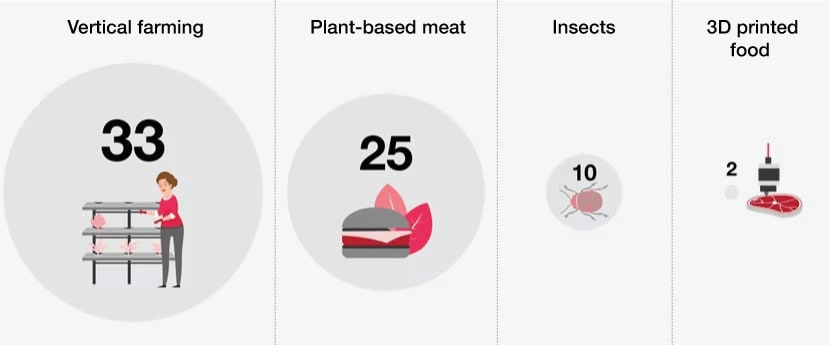{{item.title}}
{{item.text}}

{{item.text}}
Food production is inextricably linked to virtually all of the significant challenges faced by society. These include climate change, drinking water shortages, disruption of global food supply chains due to the conflict in Ukraine, the COVID pandemic, or corruption. The war in Ukraine alone this year has translated into a more than 58% increase in the price of selected food products, increasing the level of people's malnutrition in some countries around the world. Therefore, taking a closer look at how food is produced is becoming a critical economic need, and a collective effort to ensure the sufficiency and availability of food in the world is one of humanity's most important goals.
Current food production methods are highly resource-intensive, particularly regarding land, water, and detergents. This direction of development could be more sustainable in the long term. Currently, agricultural production accounts for 26% of global greenhouse gas emissions, 50% of available land utilization, and 70% of water usage. 94% of the weight of the world's mammals (excluding humans) are animals raised for human consumption. The UN estimates that by 2050 there will be nearly 9.6 billion people on earth. In the current consumption and production model, we would need three planets Earths to provide enough food for everyone. This means that well before 2050, we must bring about radical changes in diet and agricultural production methods.
Poland, the 6th largest food producer in the European Union, plays an essential role in the European market, with a highly developed meat industry. In Poland, more than 2.7 million tons of poultry (#1 in the EU), 1.9 million tons of pork (#4 in the EU), and 0.6 million tons of beef (#7 in the EU) are produced annually. Poland is also a significant producer of dairy products (#5 in the EU) and selected vegetables and fruits. On the other hand, Poland is already a developed market, with complete access to new technologies and European funds dedicated to transforming food production.
Krzysztof Badowski,
managing Partner,
Strategy& Poland
Despite the increasing production of meat in Poland, positive changes in behavior among Polish consumers are visible. In 2022, meat consumption (including giblets) reached about 76 kg per capita, thus lower than in 2021 by about 1.5 kg. In 2023, meat consumption is expected to drop to 74-75 kg per capita. However, the decline may be more significant depending on inflation and the purchasing power of the zloty.
The challenge, however, is growing export, which regularly increases pressure on Poland's meat production and forces greater concentration and specialization in livestock production. Consequently, this leads to water, soil, and air pollution. Moreover, it also affects the marginalization of smaller farms (less than 15 hectares) and changes how animals are raised. Notably, only 1.4% of farms in Poland used organic production methods in 2020, which shows that high-intensity farming dominates in Poland.
The current situation provokes the question of the future direction of the meat industry in Poland, where, on the one hand, increased industrialization and increased intensification are visible, and on the other, the pursuit of sustainable development goals.
These are, sequentially:
There are many reasons for the overuse of natural resources, but one of the main ones is increased meat consumption. The amount of meat produced has tripled in the past 50 years, and per capita has nearly doubled from 23 kg per person annually in 1961 to 43 kg per person in 2021. Meat production, especially beef, is the most inefficient form of agricultural production, requiring almost 100 times more natural resources than producing the same amount of calories from plant products. Just replacing beef with poultry meat would result in a 50% reduction in greenhouse gas emissions from agricultural production and a 30% drop in freshwater consumption by agriculture.
Average greenhouse gas emissions in CO2 equivalent per kilogram
Estimated range of global avoidable losses by production stage
The UN estimates that nearly 1/3 of all food is wasted due to delays and inefficiencies in supply chains. This is due to underinvestment in logistics and the slow adoption of digital solutions, such as real-time tracking of product parameters and storage conditions. The technologies above, production closer to the place of consumption, and many others have the potential to significantly reduce losses in supply chains and improve the use of available acreage.
Agricultural production is also an area that needs significant support with new technologies. Increasing the biodiversity of production and production closer to the places of consumption will also remain important. Data-supported agriculture will enable a much more precise application of water and nutrients and provide good-quality light, thus increasing the yield per square meter of acreage. Vertical farming will allow further reduction in the use of space, as well as locating production closer to places of actual consumption. Innovations in alternative sources of nutrients, such as "plant-based meat," the use of insects as a source of protein, or the print of meat without the need to raise animals, will also remain important.
Projected share of alternative food production methods in 2030 (billion USD).
Despite the growing awareness of Polish consumers, food production and consumption sustainability requires additional action. The main areas to be addressed are consistent actions across the EU, promoting consumer awareness, and improving meat production conditions.
{{item.text}}

{{item.text}}
Krzysztof Badowski





